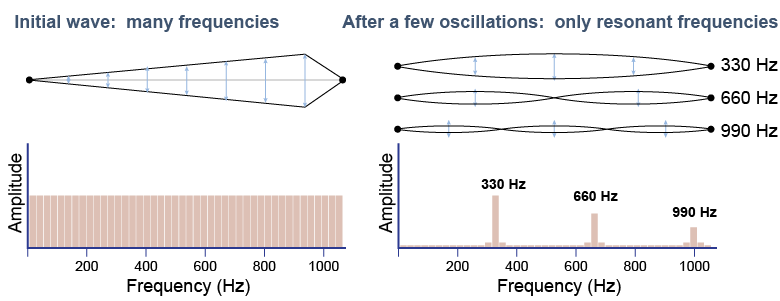|
Waves are a fundamental way through which energy moves. Resonance dramatically affects the energy content of waves. Resonance preserves the energy of waves of certain frequencies while all other frequencies rapidly damp out to zero amplitude. Every wave in your daily environment, including light waves, sound waves, vibrations of the ground, and radio waves, is shaped by resonance. Many technologies, such as microwaves, musical instruments, and magnetic resonance imaging (MRI) scanners explicitly use resonance. 
|
Consider what happens when you pluck the string of a guitar. A 67 cm E string at a tension of 72 N vibrates at 330 Hz. Why? You do not pluck the string 330 times per second, yet somehow the string turns your single pluck into vibrations at this precise frequency (and its harmonics). The first part of the explanation is that many waves are present in the initial oscillation, at many frequencies, because a string is capable of vibrating at an infinite number of frequencies. 
|

|
Within a few oscillations, friction damps nonresonant frequencies to zero amplitude. Resonant frequencies, however, lose energy much more slowly. After a very short time only the resonant frequencies are left with appreciable amplitude! Resonance preserves only the energy of standing waves at the string’s natural frequencies, so the string vibrates at these frequencies no matter how it is plucked! 
|

|
The frequencies of oscillation are illustrated above in a form of bar chart called a spectrogram, in which the amplitude of each frequency is plotted as a vertical bar. You can easily see which resonant frequencies are present in the right-hand chart. 
|
Resonance in standing waves is created by constructive interference between a wave and its reflections from the boundaries of the system. Technologies such as musical instruments and microwave ovens control the frequency of waves by creating systems with boundaries that create resonance at the desired frequencies. MRI uses resonance in the reverse way. Systems also absorb energy very efficiently at their resonant frequencies and not at other frequencies. Atoms act like microscopic standing waves and atoms of different elements have different resonant frequencies. 
|
| |
|

